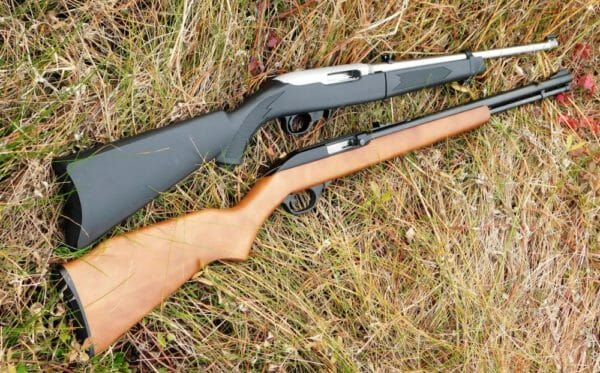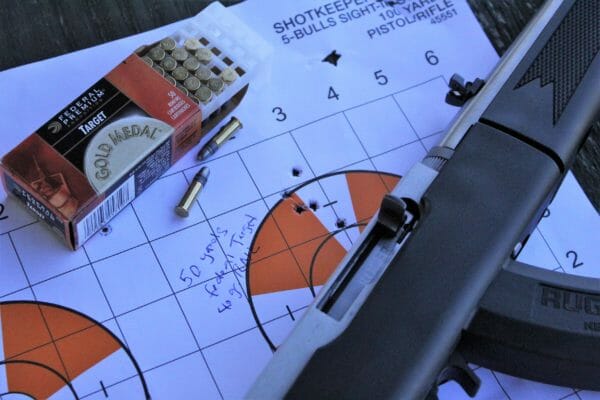Opinion
Terril brings us a fun comparison between the two best-selling 22 rifles: the Marlin Model 60 and the Ruger 10/22.
USA – –AmmoLand.com)- I am often asked what caliber or firearm is best for a given task. This is surprising, considering I don’t look like a guy you would ask directions to the airport, let alone anything of consequence like guns and ammo. Which is better? 9 or 45? Revolver or autoloader? SD9VE verses anything by Taurus?
I don’t keep a dog in those fights, but I have long wondered which 22 rifle was best: the Marlin Model 60 or the Ruger 10/22.

Taken together, these have been the best selling rimfire rifles on the American market for decades and each rifle has their cult following. I have not swallowed the flavor-aid and slashed my palms to initiate myself into the cult of the Microgroove or the Bill Ruger, but I have a sampling of both rifles and I decided to put them side by side at the range for a little comparison.
The Marlin Model 60

The Marlin Firearms Company, a legend in the rifle world, is still producing several variations of their bread-and-butter rifle–the Model 60. The Model 60 came out in…1960. It was not the first auto-loading 22 rifle, but it is one that has stood the test of time and company mergers. Sporting a twenty-one inch Microgroove-rifled bull-barrel and an eighteen shot tubular magazine, the Model 60 has developed a reputation as an unusually accurate rimfire rifle. In the 1980s, Marlin ditched their long gun in response to magazine capacity legislation. The modern configuration you will see now sports a shorter nineteen-inch barrel and a fifteen-shot magazine, allowing it to be sold in more places where three rounds mean the difference between friendly hunting rifle and instrument of mass destruction.
In 2007, Remington bought Marlin. There are complaints about the quality control on many of their models in the years since, but in my experience, the Model 60 has suffered little. My 2017 produced “Remlin” Model 60 has been an excellent shooter, but compared to the Ruger 10/22, the Model 60 is old-school.
The Ruger 10/22

Bill Ruger started his company on 22 caliber pistols and revolvers like the Mk I pistol and the Single-Six. Naturally, a 22 rifle was in order. As it was introduced in 1964, the Ruger 10/22 has changed very little. But aftermarket improvements on the platform have become an industry unto itself, from higher capacity magazines, to target triggers, to stock options. In my case, I have the base-model Takedown model first introduced a few years ago. Other than that, it has a stock ten-shot detachable rotary magazine and a tapered 18.5-inch barrel. The rifle’s modularity and the advent of relatively reliable higher-capacity magazines like the BX-25 put it in an arena of firepower that its competitors struggle to keep up. But the battle continues.
Accuracy
Proponents of the Marlin Model 60 adhere to the model’s inherent out-of-the-box accuracy. Marlin’s Microgroove rifling–essentially smaller and more numerous grooves in the barrel–leads to less deformation of the bullet on its journey out of bore on its way to the target, making for better accuracy.
I am no engineer. I am a lazy liberal arts guy. I will say that my Model 60 is generally a little more accurate for me, but that statement is complicated.
The black-on-black sheet metal u-notch rear sight is adjustable for windage and elevation, while the front blade is fixed on the barrel. The iron sights don’t leave much room for taking a very fine sight-picture, especially in low light. But the Model 60 is a heavier rifle with a heavier bull barrel and that does allow for a steadier hold, provided you are adult-sized. The Ruger 10/22 is a lighter rifle and more prone to moving around if you aren’t steady and the lighter, tapered barrel would lead to the assumption of less accuracy. However the Ruger’s white-diamond rear sight and gold-beaded post front are quite clean compared to the Marlin.
Its a combination of gun, ammo, and shooter that make for accurate shooting. I put both guns on paper from a rest at fifty-yards’ distance using Federal High-Velocity Match 40 grain loads, a load that provides consistent results in the 22 LR firearms I have. Taking my fliers out of the picture, the Marlin was slightly more accurate. But when I switched ammunition to Federal Target 40 grain standard velocity loads, loads I now shot sub-MOA groups out of my Ruger, the Ruger spanked the Marlin. The Marlin might be more steady, but it is not automatically more accurate than the Ruger.

Reliability
Both the Marlin and the Ruger exhibit excellent reliability for what they are, but all rimfire rifles are subject to misfires from bulk or bad ammunition and hung-up cases once the guns become very dirty. I don’t shoot both rifles excessively, but I have over two thousand rounds through both rifles and a few interesting observations. I won’t dwell on this for too long as reliability is dependent on maintenance and the diet of ammunition you feed the rifle, but there are unique problems that affect both rifles.
The Ruger 10/22s I have shot through the years tend to feed round-nosed ammunition better than flat-faced rounds. I had no such problem in the Marlins I have run.
Magazine Woes
One aspect of reliability lies in the magazines when it comes to autoloaders, especially 22s. There is also the issue of spring compression, an issue some ascribe as a myth. In the case of rimfire rifles, it most certainly is not. As it pertains to our samples, I generally leave the Marlin’s tube magazine downloaded with thirteen rounds loaded for two or three months on end. The rifle runs those rounds perfectly fine. The same is true for a fully loaded ten-round magazine in the Ruger. The few BX-25 magazines I kept loaded with twenty-three rounds for that same period of time choke constantly with the spring and follower getting stuck in place unable to move rounds further up into the magazine. I have to take the magazine out, strike it once, and reinsert to keep firing.
The Marlin has just one magazine to worry about but even that is not perfect. Too much gun oil on the brass magazine tube combined with a chilly day meant a stuck magazine tube that left me red and raw trying to get it out, which I eventually did.
The Marlin also uses a feed throat to feed rounds from the magazine to the chamber. Some shooters with tens of thousands of rounds in their guns state that the feed throat wears out over time and needs to be swapped out. In the case of the Ruger, discarding old magazines and replacing them seems like a more straightforward bet.
Points of Disassembly
The Marlin and the Ruger disassemble in a similar fashion. The components that come out of the receiver are a heavy steel bolt, a stout spring, the charging handle, and a guide rod. In the case of the Marlin, the charging handle is pulled out as the bolt is lifted out of the receiver. The guide rod, spring, and charging handle are all one integral unit with the Ruger. I have to fight to get this unit back in while sandwiching the bolt back on top of it for reassembling. The Marlin does not have such a problem. It is worth pointing out that the Marlin has two opposing extractors on the bolt, whereas the Ruger only has one. This might explain why I get fewer stuck cases when firing the Marlin to the point of being fouled out.
Features
The Marlin Model 60 and the Ruger 10/22 are both excellent rifles with their own downsides, but it is the features that are the true deciding factor. Perhaps the biggest difference is loading and unloading.
The Ruger 10/22 uses a polymer-based rotary magazine with steel feed lips. In the box, you will get one ten-shot magazine. The Marlin uses an under-barrel tubular magazine. The magazine tube needs to be pulled out and individual cartridges dropped in the tube all the while you are working around the muzzle of the gun. The magazine holds fifteen shots, but it is not as fast as switching out Ruger magazines, nevermind the potential safety concerns. The Marlin does have a last-shot hold open that the Ruger does not. Both rifles can be locked open by jacking the charging handle back and pushing inward so you are working with a safe gun. On the other hand, inserting a new magazine beats fumbling with loose ammunition in cold weather if you are having to reload in the field. My friends in the Colorado Rockies can attest to that.
Perhaps more importantly, feeding also translates into malfunction clearance. In the worst double feed, in which one round feeds behind a stuck case or an otherwise unspent round, I have to pull the Marlin’s magazine tube out and dump the ammunition to clear the jam. With the Ruger, just take out the magazine, run the charging handle, insert the magazine and go back to the task.
The Ruger 10/22 has a clearly better scope mounting option. The receiver is tapped and drilled for a Weaver scope base, allowing you to install anything from red-dots to high-power rifle scopes. Whereas the Model 60 has a traditional 3/8 inch dovetail milled into the receiver. This allows you to fit a conventional low-powered rimfire scope. You would have to buy a 3/8 inch to Weaver adapter to make the jump to more sophisticated optics.
The Model 60 is an adult-sized gun with a full-length buttstock. The comb of the stock is more pronounced than on the Ruger. When looking down the sights, I have to press my head further down on the stock to line up a shot. The Ruger’s stock is a little shorter and the drop of the comb is more pronounced allowing for a more comfortable sight picture. I got my first 10/22 when I was a foot and a half shorter and the rifle fits me like a glove then and now.
The Price You Pay

I avoid naming prices because they fluctuate with time, location, and variation away from the base model of firearm. Some, including myself, feel that the Marlin is a lot of gun for only $150-$180. The Ruger is easily $50 more. Throw in a few extra magazines and the price tag is more than negligible if you have or want to invest as little as possible.
The Bottom Line
It has been some time since I reviewed both the Marlin Model 60 and the Ruger 10/22 separately, but throwing them together with more trigger time gave me more to like and dislike. The Marlin is generally more accurate with cheap ammo, has an easier-to-understand disassembly procedure, and a higher out-of-the-box capacity in an all-inclusive package that needs only a scope to complete. For a little more money and with good ammo, you can get a Ruger that can best the Marlin in accuracy with a modularity that the latter can’t touch, though both rifles have their fair share of aftermarket support. Both have their weak points. The Marlin is slower to load and the feeding mechanism can wear over time, whereas the Ruger’s issues can be fixed by changing magazines. The Ruger is easier to shoulder, but the Marlin holds steadier. In my subjective view, the Ruger 10/22 is the more versatile rifle, but the Marlin Model 60 is the most complete package at a somewhat better price tag.
Which is your favorite?
About Terril Hebert
Terril Hebert is a firearm writer native to south Louisiana. Under his motto-Guns, Never Politics-he tackles firearm and reloading topics both in print and on his Mark3smle YouTube channel, where he got his start. Terril has a soft spot for ballistics testing, pocket pistols, and French rifles. When he is not burning ammo, he is indulging his unhealthy wildlife photography obsession or working on his latest novel. Scourge of God, published in 2017. See more from Terril on youtube under Mark3smle
